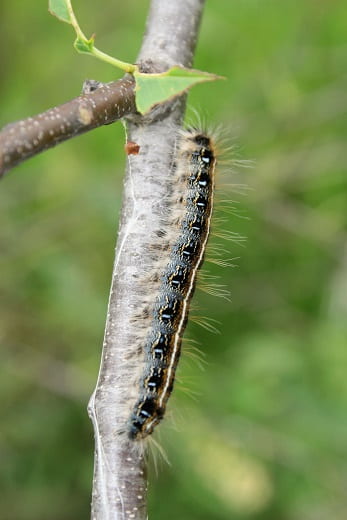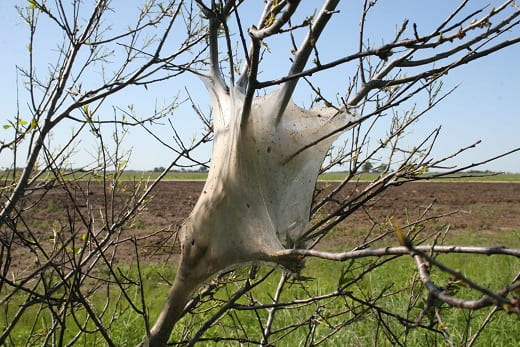–by Raymond Cloyd
The larvae (caterpillars) of the Eastern tent caterpillar, Malacosoma americanum, have hatched from eggs are feeding on the leaves of trees and shrubs (Figure 1).
Fig 1. Eastern Tent Caterpillar Feeding On New Leaves (Auth–Raymond Cloyd, KSU)
After caterpillar’s hatch from eggs, they create a distinct white, silken nest (or tent) in the branch crotches of trees and shrubs (Figure 2)
Fig 2. Eastern Tent Caterpillar Tent or Nest (Auth–Raymond Cloyd, KSU)
including: birch, crabapple, hawthorn, mountain ash, poplar, willow, and flowering cherry, peach, and plum. The nest protects caterpillars from cold temperatures.
Caterpillars are black with a distinct light stripe that extends the length of the back and there are blue markings on the side of the body (Figure 3).
Fig 3. Eastern Tent Caterpillar (Auth–Raymond Cloyd, KSU)
There are five instars (stages between each molt). Eastern tent caterpillar is one of our earliest caterpillar defoliators, feeding on newly-emerged leaves, which reduces the ability of trees and shrubs to produce food by means of photosynthesis. Although feeding damage may not directly kill a tree or shrub, a decrease in photosynthesis can predispose plants to secondary pests such as wood-boring insects. Leaf quality can influence tree and shrub susceptibility to feeding. For instance, black cherry trees grown in the shade are less fed upon by Eastern tent caterpillars due to lower leaf nutritional quality.
The young or early instar (1st through 3rd) caterpillars are active during the daytime and reside in the silken nest at night. During the day caterpillars emerge from the silken nest and feed on plant leaves. On over-cast or cloudy days, caterpillars will remain inside the silken nest. The final instar (5th) caterpillar only feeds at night. The length time of time that caterpillars spend feeding increases 4-fold between the 1st and 5th instars. However, feeding activity is contingent on temperature with caterpillars feeding longer under warmer temperatures than cooler temperatures. Eastern tent caterpillar overwinters as an egg mass attached to the branches or small twigs (Figure 4). There is one generation per year in Kansas.
Fig 4. Eastern Tent Caterpillar Egg Mass Attached To Branch (Auth–Raymond Cloyd, KSU)
The silken nests can be physically removed or disrupted by hand. You can destroy, disrupt, or open-up the silken nest using a rake or a forceful water spray. The young exposed caterpillars are susceptible to consumption by birds whereas the later instars are less fed upon because the hairs on the body deter birds from feeding on them.
Spray applications of the bacterium, Bacillus thuringiensis subsp. kurstaki, or spinosad are effective in killing small (young) caterpillars and suppressing minor infestations of Eastern tent caterpillar. These insecticides are stomach poisons so caterpillars must ingest the material to be negatively affected. However, when caterpillars are mature and approximately 2 inches long, then pyrethroid-based insecticides (e.g. bifenthrin, cyfluthrin, and lambda-cyhalothrin) will need to be applied. It is important to apply insecticides when caterpillars are active during the daytime to increase exposure to the insecticide. For more information on managing Eastern tent caterpillar populations contact your county or state extension specialist.



